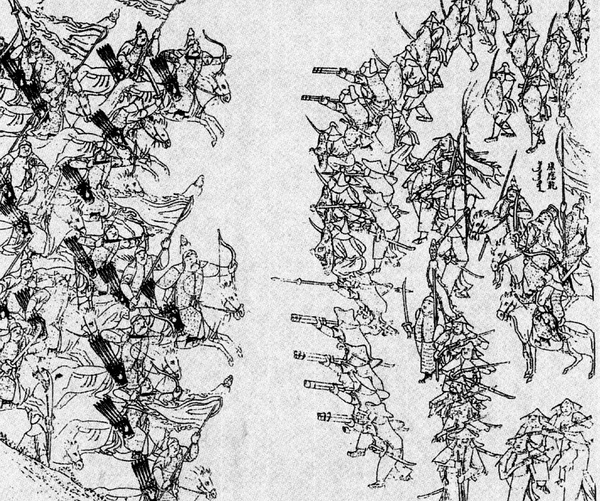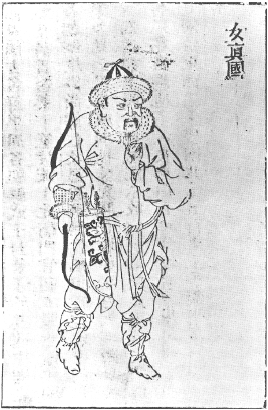|
Hešeri
Hešeri (; Manchu: ''Hešeri''), is a clan of Manchu nobility with Jianzhou Jurchens roots, originally hailing from the area which is now the modern Chinese provinces of Jilin and Liaoning. It was once one of the most important and powerful noble families in the early Qing dynasty in China, second only to the royal House of Aisin Gioro, to whom they were closely related by marriage. The power of the Hešeri family reached its zenith in the period of Duke Hešeri Sonin and his third son Lord Hešeri Songgotu (from approximately 1650 to 1705). Although its influence declined following Songgotu's death, the Hešeri clan continued to be the hereditary nobility and play a role in Chinese politics until the demise of the Qing dynasty in early 1912. History Origins The name Hešeri was first recorded in the ''Thirty Common Surnames of Jurchen'' during the later Tang dynasty (c. 800-850), and is said to be derived from the name of an ancestral river (''šeri'' loosely translating to ... [...More Info...] [...Related Items...] OR: [Wikipedia] [Google] [Baidu] |
Empress Xiaochengren
Empress Xiaochengren (3 February 1654 – 6 June 1674), of the Manchu Plain Yellow Banner Hešeri clan, was a posthumous name bestowed to the wife and first empress consort of Xuanye, the Kangxi Emperor. She was empress consort of Qing from 1665 until her death in 1674. Although her marriage was a purely political one, the Kangxi Emperor was very fond of her and left the position of empress vacant for about three years after her death. Life Family background Empress Xiaochengren's personal name was not recorded in history. * Father: Gabula (d.1681), served as a first rank military official (), and held the title of a first class duke () ** Paternal grandfather: Sonin (1601–1667), served as one of the Four Regents of the Kangxi Emperor, and held the title of a first class duke () ** Third paternal uncle: Songgotu (1636–1703) ** Fifth paternal uncle: Xinyu, held the title of a first class earl () ** Sixth paternal uncle: Fabao, held the title of a first class duke () * T ... [...More Info...] [...Related Items...] OR: [Wikipedia] [Google] [Baidu] |
Hešeri Sonin
Soni (1601–1667), also known as Sonin, and rarely Sony ( mnc, ; ), was a Manchu noble of the Hešeri clan who served as one of the Four Regents of the Kangxi Emperor (r. 1661–1722) during the Qing dynasty (1644–1912). His clan belonged to the Plain Yellow Banner. Early life Soni's father Šose (Chinese: Shuose 硕色) and uncle Hife (Xifu 希福), who were both fluent in Mandarin, Mongolian and Manchu, served as high officials under Manchu patriarch Nurhaci (1559–1626). Like them, Soni was valued for his linguistic abilities. In 1628, under Nurhaci's successor Hong Taiji (1592–1643), Soni led a successful diplomatic mission to convince the recently surrendered Khorchin Mongols to honor their pledge to help the Manchus militarily. In 1629 he was named to the newly created "Literary Office" (Chinese: ''wenguan'' 文館), an institution that kept a detailed record of Manchu history and translated Chinese books about statecraft and Chinese and Korean state documents ... [...More Info...] [...Related Items...] OR: [Wikipedia] [Google] [Baidu] |
Songgotu
Songgotu (Manchu: ; ; 1636 – 1703) was a minister during the reign of the Kangxi Emperor of the Qing dynasty. He was an uncle of the emperor's primary spouse, Empress Xiaochengren of the Hešeri clan, who died during childbirth. He was also the son of Sonin, one of the four regents appointed to assist the young Kangxi Emperor during his minority. As Empress Xiaochengren's paternal uncle, he was also therefore, the grand-uncle of Yinreng, who was crown prince throughout most of the Kangxi Emperor's reign. Songgotu did not inherit the noble title First-class Duke or First-class Earl from his father Sonin because his mother was not the primary consort, therefore, he had the lowest status of his brothers. His sixth brother and fifth brother inherited the noble titles First-class Duke and First-class Count. His oldest brother, Gabula, was Empress Xiaochengren's father, and he also had the noble title First-class Duke. Songgotu helped the young Kangxi Emperor depose Oboi, a ... [...More Info...] [...Related Items...] OR: [Wikipedia] [Google] [Baidu] |
Four Regents Of The Kangxi Emperor
The Four Regents of the Kangxi Emperor were nominated by the Shunzhi Emperor to oversee the government of the Qing dynasty during the early reign of the Kangxi Emperor before he came of age. The four were Sonin, Ebilun, Suksaha, and Oboi. Background The Shunzhi Emperor died in 1661 and was succeeded by his six-year-old son, who was enthroned as the Kangxi Emperor. Before the Shunzhi Emperor died, he appointed four interior ministers – Sonin, Suksaha, Ebilun and Oboi – to assist the Kangxi Emperor as regents. This period of regency in the Qing dynasty was known as the "Four Regents period". The Kangxi Emperor only took full control of the government in May 1669. Early regency In the initial stage of the regency, the four regents oversaw the government together and provided assistance towards each other in accordance with the Shunzhi Emperor's dying wishes. They continued the war against resistance forces loyal to the Ming dynasty (the dynasty before the Qing dynasty). In Apr ... [...More Info...] [...Related Items...] OR: [Wikipedia] [Google] [Baidu] |
Manchu
The Manchus (; ) are a Tungusic peoples, Tungusic East Asian people, East Asian ethnic group native to Manchuria in Northeast Asia. They are an officially recognized Ethnic minorities in China, ethnic minority in China and the people from whom Manchuria derives its name. The Later Jin (1616–1636), Later Jin (1616–1636) and Qing dynasty, Qing (1636–1912) dynasties of China were established and ruled by the Manchus, who are descended from the Jurchen people who earlier established the Jin dynasty (1115–1234), Jin dynasty (1115–1234) in northern China. Manchus form the largest branch of the Tungusic peoples and are distributed throughout China, forming the fourth largest ethnic group in the country. They are found in 31 Chinese provincial regions. Among them, Liaoning has the largest population and Hebei, Heilongjiang, Jilin, Inner Mongolia and Beijing have over 100,000 Manchu residents. About half of the population live in Liaoning and one-fifth in Hebei. There are a ... [...More Info...] [...Related Items...] OR: [Wikipedia] [Google] [Baidu] |
Mongolian Language
Mongolian is the Prestige (sociolinguistics), principal language of the Mongolic languages, Mongolic language family that originated in the Mongolian Plateau. It is spoken by ethnic Mongols and other closely related Mongolic peoples who are native to modern Mongolia and surrounding parts of East Asia, East, Central Asia, Central and North Asia. Mongolian is the official language of Mongolia and Inner Mongolia and a recognized language of Xinjiang and Qinghai. The number of speakers across all its dialects may be 5–6 million, including the vast majority of the residents of Mongolia and many of the Mongols in China, ethnic Mongol residents of the Inner Mongolia of China. In Mongolia, Khalkha Mongolian is predominant, and is currently written in both Cyrillic script, Cyrillic and the traditional Mongolian script. In Inner Mongolia, it is dialectally more diverse and written in the traditional Mongolian script. However, Mongols in both countries often use the Latin script for conve ... [...More Info...] [...Related Items...] OR: [Wikipedia] [Google] [Baidu] |
Cantonese
Cantonese is the traditional prestige variety of Yue Chinese, a Sinitic language belonging to the Sino-Tibetan language family. It originated in the city of Guangzhou (formerly known as Canton) and its surrounding Pearl River Delta. While the term ''Cantonese'' specifically refers to the prestige variety, in linguistics it has often been used to refer to the entire Yue subgroup of Chinese, including related but partially mutually intelligible varieties like Taishanese. Cantonese is viewed as a vital and inseparable part of the cultural identity for its native speakers across large swaths of southeastern China, Hong Kong and Macau, as well as in overseas communities. In mainland China, it is the ''lingua franca'' of the province of Guangdong (being the majority language of the Pearl River Delta) and neighbouring areas such as Guangxi. It is also the dominant and co-official language of Hong Kong and Macau. Furthermore, Cantonese is widely spoken among overseas Chinese in ... [...More Info...] [...Related Items...] OR: [Wikipedia] [Google] [Baidu] |
Nurhaci
Nurhaci (14 May 1559 – 30 September 1626), also known by his temple name as the Emperor Taizu of Qing, was the founding khan of the Jurchen people, Jurchen-led Later Jin (1616–1636), Later Jin dynasty. As the leader of the House of Aisin-Gioro, Nurhaci reorganized and united various Jurchen tribes (the later "Manchu people, Manchu"), consolidated the Eight Banners military system, and eventually launched attacks on both the Ming dynasty, Ming and Joseon dynasties. His conquest of Ming dynasty's northeastern Liaodong region laid the groundwork for the Qing conquest of the Ming by his descendants, who proclaimed the Qing dynasty in 1636. He is also generally credited with ordering the creation of a new written script for the Manchu language based on the Mongolian script, Mongolian vertical script. Name and titles Nurhaci is written as in Manchu language. Some suggest that the meaning of the name in the Manchu language is "the skin of a wild boar". Another explanation is "brav ... [...More Info...] [...Related Items...] OR: [Wikipedia] [Google] [Baidu] |
Shunzhi Emperor
The Shunzhi Emperor (15 March 1638 – 5 February 1661), also known by his temple name Emperor Shizu of Qing, personal name Fulin, was the second Emperor of China, emperor of the Qing dynasty, and the first Qing emperor to rule over China proper. Upon the death of his father Hong Taiji, a Deliberative Council of Princes and Ministers, committee of Manchu princes chose the 5-year-old Fulin as successor. The princes also appointed two co-regents: Dorgon, the 14th son of Nurhaci, and Jirgalang, one of Nurhaci's nephews, both of whom were members of the Qing imperial clan. In November 1644, the Shunzhi Emperor was enthroned as emperor of China in Beijing. From 1643 to 1650, political power lay mostly in the hands of the prince regent Dorgon. Under his leadership, the Qing conquered most of the territory of the fallen Ming dynasty, chased Southern Ming, Ming loyalist regimes deep into the southwestern provinces, and established the basis of Qing rule over China proper despite highl ... [...More Info...] [...Related Items...] OR: [Wikipedia] [Google] [Baidu] |


